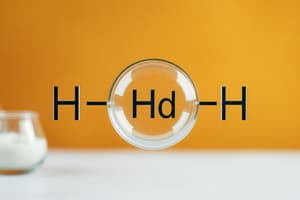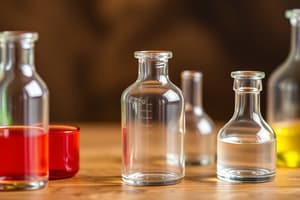Podcast
Questions and Answers
Under what circumstance does the law of definite proportion not apply?
Under what circumstance does the law of definite proportion not apply?
- When elements react to form ionic compounds
- When elements are in a gaseous state
- When different isotopes of combining elements are used (correct)
- When compounds are formed at high temperatures
What assumption did Dalton make regarding the compounds of two elements?
What assumption did Dalton make regarding the compounds of two elements?
- They consist of three or more different elements
- They are always neutral in charge
- They must be binary compounds (correct)
- They could only be formed from nonmetals
How many atoms are present in a molecule of Ozone?
How many atoms are present in a molecule of Ozone?
- 2
- 3 (correct)
- 8
- 4
Which of the following elements has an atomicity of 4?
Which of the following elements has an atomicity of 4?
What is the term used for a group of atoms carrying a charge?
What is the term used for a group of atoms carrying a charge?
Which of the following is an example of a monoatomic molecule?
Which of the following is an example of a monoatomic molecule?
How is the symbol for an element generally derived?
How is the symbol for an element generally derived?
What does valency represent in an atom?
What does valency represent in an atom?
Flashcards
Atom
Atom
The smallest particle of an element that can take part in a chemical reaction. It may or may not exist freely. Each atom of an element exhibits all the properties of the element.
Molecule
Molecule
The smallest particle of matter (element or compound) that can exist in a free state. The properties of a substance are the properties of its molecules.
Atomicity
Atomicity
The number of atoms present in a molecule of a substance (element or compound).
Polyatomic ion
Polyatomic ion
Signup and view all the flashcards
Valency
Valency
Signup and view all the flashcards
Law of Definite Proportions
Law of Definite Proportions
Signup and view all the flashcards
Dalton's Atomic Theory
Dalton's Atomic Theory
Signup and view all the flashcards
Chemical Formula
Chemical Formula
Signup and view all the flashcards
Study Notes
Laws of Chemical Combination
- The law of definite proportions does not apply consistently when isotopes of elements are used in a compound.
- Dalton's atomic theory explained existing laws of chemical combination. He assumed the simplest compound of two elements is binary.
Atoms, Molecules, Ions & Chemical Formulas
- Atom: The smallest particle of an element that can participate in a chemical reaction. May or may not exist independently. Each atom possesses the properties of the element.
- Molecule: The smallest particle of matter (element or compound) that can exist independently. A substance's properties are the same as its molecules' properties.
- Element Molecules: Composed of the same type of atoms.
- Compound Molecules: Formed when atoms of different elements combine in definite proportions (heteratomic molecules).
- Atomicty: The number of atoms in a molecule of a substance (element or compound).
- Elements:
- Ozone (O3): Atomicty - 3
- Phosphorus (P4): Atomicty - 4
- Sulfur (S8): Atomicty - 8
- Oxygen (O2): Atomicty - 2
- Types of Molecules Based on Atomicty:
- Monoatomic: Noble gases (e.g., Helium (He), Neon (Ne), Argon (Ar))
- Diatomic:
- Triatomic:
Symbols
- Element symbols are usually the first letter of the English name in capital.
- If multiple elements start with the same letter, the second letter is used in the symbol.
- Some symbols are derived from Latin names.
- Sodium (Na) / Natrium:
- Copper (Cu) / Cuprum:
- Potassium (K) / Kalium:
- Iron (Fe) / Ferrum:
- Mercury (Hg) / Hydragyrum:
- Tungsten (W) / Wolfram:
Polyatomic Ions
- A group of atoms with a net charge.
Valency
- The combining capacity of an atom. This is the number of electrons an atom can lose, gain, or share to form a bond.
Chemical Formulas
- A concise way to represent elements and compounds.
- Chemical formulas follow certain rules (e.g., the criss-cross rule)
Studying That Suits You
Use AI to generate personalized quizzes and flashcards to suit your learning preferences.




